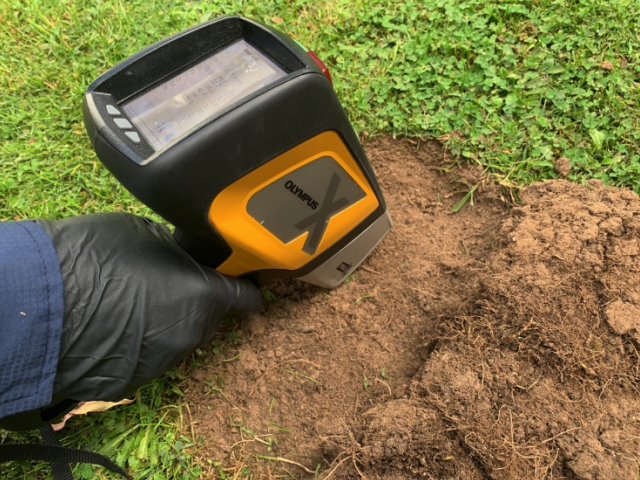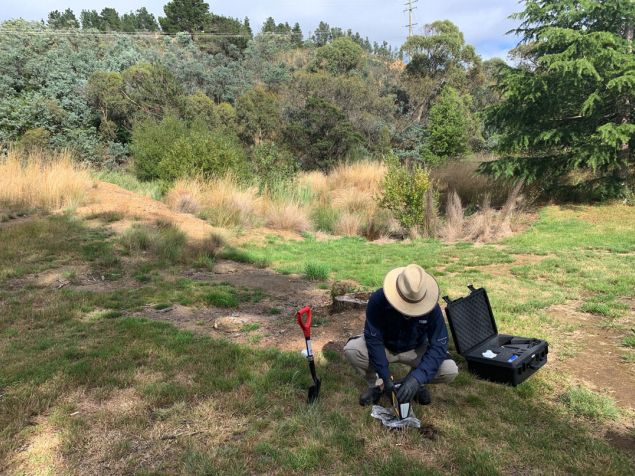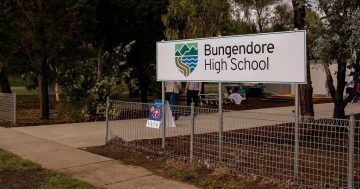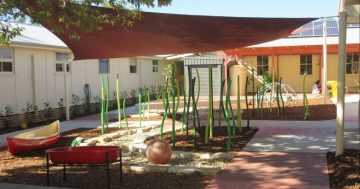
Screening soil at Captains Flat with an XRF analyser. Photo: David Langston, EPA.
Teachers and management at the Captains Flat Preschool say they remain unsure what actions will be taken to remediate lead contamination found to be well above the levels considered safe.
According to a report released this week by the NSW Environment Protection Agency (EPA), the results of 80 soil samples in Captains Flat found some areas of the town, including in and near the pre-school, had high levels of lead contamination from the former Lake George Mine.
The testing report found that an area outside the school had 1900 micrograms of lead per kilogram of soil (mg/kg) on 3 February, while one sample from a reserve behind the pre-school had much higher levels of 3100 mg/kg of lead on 9 February. Another sample had 2400 mg/kg of lead in the soil.
These are well above the safe level of 300 mg/kg of soil for residential land and schools, and 600 mg/kg for parks and reserves.
Three samples within the pre-school grounds had lead levels of 850, 790 and 320 mg/kg.
A small disused garden at the primary school also returned slightly elevated lead levels, but the garden is not in use and is not accessible to students.
In a letter to all families on 11 March, the Captains Flat Pre-School management committee and teachers said they were still unsure what actions the NSW Government would take to ensure the school is safe.

An EPA sampler screening soil for lead contamination at Captains Flat. Photo: David Langston, EPA.
“Many of the decisions are not ours to make; however, we will keep asking for answers to our questions and pushing for action as quickly as possible,” the letter said.
“The long-term solution to remediate our preschool playground and surrounding areas is unknown at this stage and is out of our hands. We have no idea as to how or when this will take place.
“As our pre-school is located on Crown Land, they are responsible for this work, and as yet, we have not received a plan or likely timeframe from them.”
The pre-school was shut down for a week from 8 to 15 February after initial tests revealed unsafe levels of lead at areas of the school. Access to the outside area of the pre-school is still restricted.
The school’s classroom, store areas, equipment and all outdoor equipment has also had a deep clean for heavy metals.
Testing the school’s water tank also found the lead level was marginally above the Australian Drinking Water Guideline health value of 10µg/L. However, the water has never been used for drinking and could be safely used for gardens and lawns and water play as lead is not readily absorbed through the skin.
The town’s water supply remains safe as it is treated and regularly monitored for compliance with guidelines.
The testing report also found 14 of the 33 soil samples tested at the laboratory had concentrations of lead above the safe level for the relevant land use.
Testing for three other contaminants (arsenic, copper and zinc) were below the levels considered safe and posed no threat to the community.
The EPA report said lead levels above the safety threshold indicate there could be a risk to human health; however, the exceedance of these levels does not necessarily pose a risk to human health.
Further tests in the northern part of the village generally returned low readings, except for the park on the corner of Foxlow and Spring streets, known as Foxlow Parklet, where the lead level was 2700 mg/kg – four-and-a-half times the safe level.
In the southern part of the village, closer to the former mine, readings were elevated above the health investigation levels for lead at some locations, including on the roadside on Foxlow Street, between the Captains Flat Hotel and the Captains Flat Fire Station.
Lead contamination from the former Lake George Mine was first detected following initial testing by the NSW EPA in the first week of February.
The mine operated from 1892 until 1962, producing lead, zinc, copper, pyrite, silver and gold.
The NSW Government has said it will work with the community to ensure they know what actions they can take to live safely with lead, including frequent hand-washing, covering patches of bare soil with grass or mulch to prevent dust, and not allowing poultry to range freely where lead is suspected or proven.














